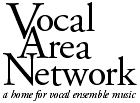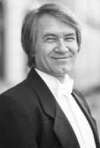 |
 |
Advertise | Sustaining Membership | VAN Store | Feedback
by Jeremy Green for Vocal Area Network
Posted November 30, 2008
 Jeremy
Green of the Russian Chamber Chorus of New York spoke recently with Maestro
Nikolai Kachanov about the group's upcoming "Winter Light" concerts.
Jeremy
Green of the Russian Chamber Chorus of New York spoke recently with Maestro
Nikolai Kachanov about the group's upcoming "Winter Light" concerts.
Jeremy Green: Maestro Kachanov, RCCNY's "Winter Light" concerts on December 10 and 13 celebrate the flow of Russian sacred music throughout the world, and includes pieces by great non-Russian composers such as the Polish composer Krzysztof Penderecki and the British composer John Tavener. What is the inspiration that Russian sacred music tradition had on these non-Russian composers in your program?
Nikolai Kachanov: There has been one long historical conversation between the Russian sacred music traditions and those of the West. For some people, Russian church music is symbolized by the Russian cathedral, with the gold cupola and bells and a certain kind of majesty expressed in music as a mighty choral tutti. But these traditions are more than just that; they include refined inner processes of meditative quality, melodic expressiveness, and mysterious, quiet recitativo. These characteristics are well reflected in our current concert program. Penderecki and Tavener, being foreign to Russia, were successful in their attempts to decode some of mysterious aspects of the Russian Orthodox tradition, providing an essence of it while keeping their original view point in their compositions.
For example, take a simple photograph, which is a capturing of "the real." And then there is the creative art that is enhanced by the imagination, such as a painting. Sometimes this kind of art, which requires the imagination to evoke an image, brings out more essence than the objective art such as the photograph.
On the one hand, these Western composers brought their own artistic currents to the works. On the other hand, they brought an essence of how they creatively perceive the Russian Orthodox sound. This is the most interesting aspect. If you ask a New Yorker to describe a New York City street corner, and then ask a tourist about the same corner, you'll probably receive very different perceptions. There is a different vision, which has a special value. It plays a mirror effect: sometimes when we see our own picture, or hear our own voice, we are surprised! We think, is that me? That is because we usually have a different idea about ourselves than people around us.
JG: It can be jarring.
NK: Yes. And the composers bring their own vision. I perceive Svyaty by Tavener as a kind of time machine which takes us into the depth of centuries: the sounds are very archaic and as though frozen in ruins of ancient churches, perhaps because Tavener is so familiar with the sounds of Greek Orthodox music, which has preserved some of its old tradition that goes back as far as ancient time in Jerusalem.
In fact, the ancient Greek culture—philosophy and art—has been a blessing and has influenced Russian traditions in many ways. It is interesting that John Tavener uses a cello part, given that Russian Orthodox church music, or Byzantine or Greek Orthodox, would have not included instruments. But for Tavener, the cello is the voice of the Priest. If you step into a cathedral or a temple and hear a beautiful sound which touches you, the voice of the Priest singing, it brings you into another realm—even though you don't understand the words, you get the feeling. The timbre of a cello is closer to the human voice, and its sound is so full of the spirit-mystery; it talks to your heart rather than to your mind. The piece has a remarkable ending in which Tavener uses a thrice-repeated dialogue between voices and cello. We hear catharsis in the final voice of cello flageolets, which to me symbolize dissolution in light.
In Cherubic Hymn, Penderecki uses a synthesis of two different dimensions: here is also an archaic melodic chanting style with asymmetric rhythms and harmonic vertical, which is typical for the monastic style of singing. When those two dimensions merge, a powerful climax is reached.
JG: What is it that attracts you to the works you choose for the Russian Chamber Chorus to perform?
NK: I like to decode things. The more question marks there are, the more I'm attracted to the music. Why has a composer done this or that in his work? The initial process of decoding is the necessary part that leads to the performance. The highest point of enjoyment to me is when I sense the unity in the choir, when every singer enthusiastically and with love gives life to the music, and when in the final step—which is the performance—we touched the hearts of our listeners.
What also attracts me is a certain kind of process where you can really lose yourself, dissolve inside that beautiful music. In the Tavener and the Penderecki pieces, you lose the sense of time. Time stands still. Both have found a Russian liturgical expression which operates outside of the metronome. Slow tempos, the meditative aspect and the complexity of the asymmetric rhythms express the composer's intention to reflect an inner psychological state of prayer and detachment so typical for Russian Orthodox liturgy.
JG: How about the Schnittke piece?
NK: Alfred Schnittke was born in Russia and died in Germany, where he became a Catholic. Known for being an innovative composer, in the three-piece cycle which we will perform, he brings a very authentic traditional liturgical Orthodox sound and plunges us into that whole atmosphere which people may experience in the Russian Orthodox church.
JG: It's also a very modern-sounding piece.
NK: But again, it is like Picasso when he makes a portrait of a person where the different parts of the subject's face and body are spaced apart. It does not mean Picasso is not objective. You see the same subject from a different point of view, and where you bring together all the elements, you cannot say it isn't true.
JG: It's just reassembled in a different way.
NK: Yes—you will hear this in the first piece. However, it will sound familiar to those with the Russian Orthodox experience because he's given respect to the tradition.
JG: What was your inspiration behind picking some of the other works the choir will perform in this concert?
NK: I love to expand the choir's versatility. The first part of the "Winter Light" concert is in the spirit of the holiday season, and in the spirit of tradition. We perform an old piece by an anonymous composer, and pieces by Bortnyansky, Tchaikovsky and Rachmaninoff. The second part of the concert is about expanding and about reflecting on this tradition.
JG: Please tell me about Golovanov. He's not very well known, is he?
NK: No, he isn't, as a composer. He was famous as the conductor in the Bolshoi Theater, from 1948 to 1953, but totally unknown as a composer. The Golovanov pieces are beautiful Christmas hymns. I wanted to serve two ideas: to give some holiday sound to our listeners, and to introduce a new name. These compositions were discovered not long ago.
JG: Is this the first time this choir has performed Golovanov?
NK: Yes, for the first time. Another interesting fact: I believe that Golovanov never heard most of his own music performed, especially the pieces that he wrote after the Revolution.
JG: Wow.
NK: Yes, and we are proud to bring life to this music. Later, history brings a balance, a chance to give life to an undeservedly forgotten music. The Russian Chamber Chorus has done this many times.
JG: Thank you very much, Maestro.
NK: Thank you.
For more on RCCNY and the upcoming concert program details, please visit www.rccny.org.
The Russian Chamber Chorus of New York's "Winter Light" concert takes place Wednesday, December 10 at 8:00 PM in St. Joseph's Church in the West Village, 371 Sixth Avenue (between Waverly and Washington); and Saturday, December 13 at 8:00 PM at the Church of St. Ignatius of Antioch, 552 West End Avenue (at 87th Street).
Jeremy Green has been a member of RCCNY since 2007.